#Sexypink/oil painters
Explore tagged Tumblr posts
Text

Sexypink - David Subran shows images of a Trinidad past.
#Sexypink/David Subran#sexypink/Brentwood Mall Atrium#Sexypink/oil painters#tumblr/David Subran#upcoming shows#trinidad and tobago#David Subran
0 notes
Text

Sexypink - major browny points!

Sexypink/ Jamaican Oil Painter Alicia Brown.





Alicia Brown’s candid imagery is so very watchable and provocative. - Sexypink
#sexypink/ Jamaican Artist#sexypink/ Alicia Brown#oil painter#tumblr/Alicia Brown#Jamaican#realism#painting
5 notes
·
View notes
Text




Sexypink - Aurora Honeywell
When I come across work I have not seen before, and it causes me to pause, it is always a special feeling and moment. I look forward to more.
#sexypink/ Aurora Honeywell#sexypink/ Trinidad and Tobago#sexypink/painting#tumblr/Aurora Honeywell#tumblr/painters#oil painting#female artists#caribbean art#trinidad and tobago#caribbean
0 notes
Text
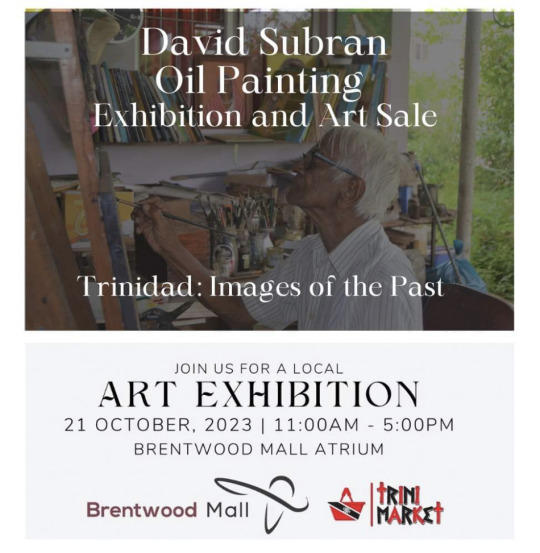
Sexypink - Subran remembers the old time days.
#sexypink/David Subran#sexypink/painters#trinidad and tobago#sexypink/on now#tumblr/oil painting#tumblr/David Subran#Trinidad:Images of the past#Brentwood Mall#paintings
1 note
·
View note
Link
~Sexypink~ I just got the very sad news of the passing of Lisa O’Connor. What a lovely person she was. I have had the pleasure of many conversations with her, both at her home and at one of the places that she loved to work, The Savanna.
The time she gave to me when discussing the book to be published, Inner Sanctum: Artists Studios was so special. I shall remember her gentle manner, her shy smile and her big heart. Rest in peace.
#Sexypink/bereavement/Lisa O'Connor#Sexypink/painting/oil#Sexypink/Lisa O'Connor#bereavement#painter#oil painting#acrylic painting#loss#death#Lisa O'Connor#plein air
1 note
·
View note
Photo

S E X Y P I N K
Our great artist Lisa O’Connor, who died in 2020, had a large stock of artist’s material in her home when she passed. Her family have generously placed all this (paints, stretched canvases, paint brushes etc etc) at 101, for young upcoming artists to take away, free of charge, anything they make good use of, in her memory.101 is open Saturday and Sunday 10am to 4pm. 628-4081
#sexypink/Lisa O'Connor#sexypink/offer#sexypink/Art materials#sexypink/Painter#tumblr/Lisa O'Connor#tumblr/in memory#tumblr/painter#painter#painting#Lisa O'Connor#oil painting#acrylic#materials
1 note
·
View note
Photo
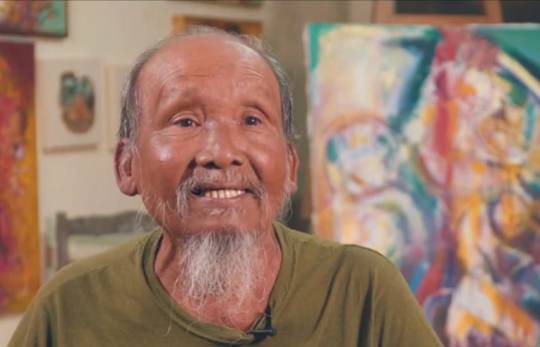
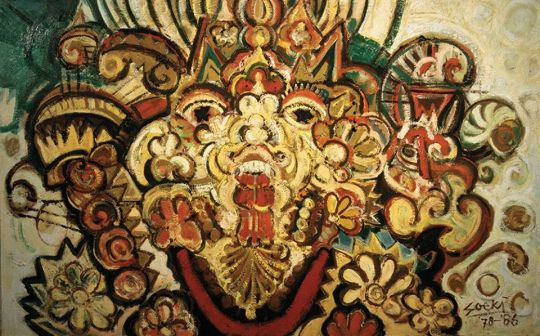
~Sexypink~ Special Surinamese artist 'Soeki' Irodikromo’ died Today the famous painter, maker of ceramic art and Batik, Sukidjan Irodokromo, died in his native country Suriname. He turned 75 years old. Soeki leaves the world special works of art. Sukidjan Irodikromo was born June 20, 1945 in Pieterszorg in Commewijne District. From 1963 to 1967 he attended a course at the Cultural Center Suriname (CCS school for Visual Arts conducted by Nola Hatterman) in Paramaribo. Back then, American President Johnson bought a painting from him, and a week later, Soeki was told that he was receiving a grant from STICUSA (Cultural Cooperation Foundation with Suriname and the Netherlands Antilles) to go to the Netherlands and study there. From 1967 to 1972 he did the free painting and chart at the Academy of Fine Arts in Rotterdam and from 1971 to 1972 he deepened himself into the ceramic. Afterwards he continued his studies with a batic training at the ASRI in Jogyakarta, Indonesia.
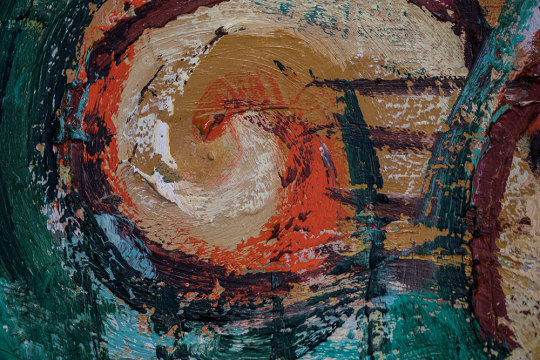
Back in Suriname he introduced batik painting there. Both in his batik cloths and oil paintings and his ceramic (vases and images), Irodikromo achieved a large production of almost constant quality. His work is in collections spread all over the world. He also made the illustrations in various books. From his admiration for Cobra expressionism, he started working in a style that connected the half abstraction of Cobra to themes and symbols from Javanese mythology. With this he was the first Surinamese artist to bring together tradition and modernity in his own idiom. Sukidjan Irodikromo's works of art are inspired by the Wayang game, Kantjil and Anansi tori. He is among the generation and caliber of Erwin de Vries, Ruben Karsters, Rudi de la Fuente and Paul Woei. Important message he leaves us is: ′′ Let your kids go to school. That gives them power. In the Netherlands I had adjustment problems and language problems. But that didn't stop me from moving on. I dared, because it's about the quality of my work ".
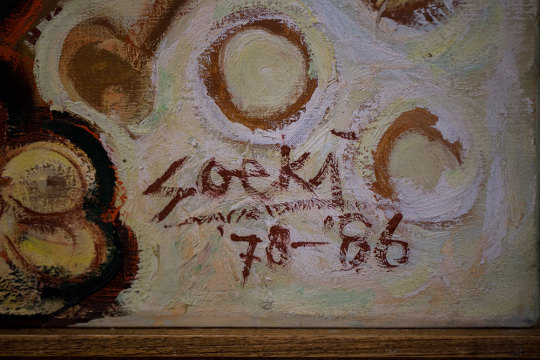
Family background
His parents were farmers. The plantation life used to be very simple. Grandpa and grandma could teach us nothing but work, because for other things they had neither time nor knowledge. Working with a ' berang ' (houwer) and ' pacol ' (hoeing) was the only thing that was taught them. Building a house was done with 'gotong royong' (mutual assistance). Neighbors and family helped each other. A lot of ' teloh ' (cassave), ' gedang ' (banana), fresh fish, such as ' teri ' (salted little fish) and ' ikan asin ' (salty fish) were eaten daily. Sometimes the family had nothing and ate rice with the oil in which the fish was baked. Meat was only eaten when someone threw a party and with 'Bada' (Sugar Fest). Father Irodikromo would have saved up for new pants for the kids.
People in that time believed in ' kersane Allah ' (God's will). ′′ I leave it to tomorrow's day was what people said. Closing the plantations was quite a vein release for many families. Also for the Irodikromo family. They subsequently used the possibility to purchase land on the plantation Koewarasan, which the family moved to.
http://www.oas.org/artsoftheamericas/soeki-irodikromo

#Sexypink/Surinamese Artist#Sexypink/Soeki Irodoromo#Sexypink/bereavement in Surinamese Art community#Soeki Irodokromo#Surinamese Art#Surinamese Painter#icon#bereavement#death
5 notes
·
View notes
Photo
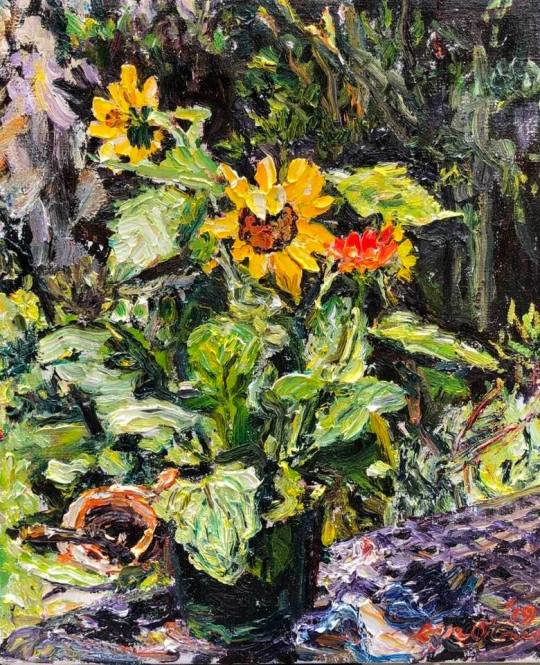
~Sexypink~ Love letter to the Late Lisa O’Connor from The Women in Art Organization of Trinidad and Tobago
LISA OCONNOR 27 May , 1965 - 22 June ,2020 Dear Lisa , I looked around the gallery today at walls that for years were full of your masterpieces .As the last of your paintings left , there was a profound emptiness inside of me at the realization that these walls would no longer hold anymore of your new works. I will so miss your vivid colors , the incredible light that each piece evokes , you created such a happy mood within each piece . As for that immense strong smell of still wet oil paints of pieces recently off your easel and along came a warning how careful I must be. A sadness hit - there would be no more phone calls - “ I’m finally finished it , it just needs to be photographed and then you can come for it !” That love and passion in your voice for each piece that you mastered. There will be no more lengthy chats , discussions and endless negotiations . You were always relentlessly strong yet you held a sincere kindness within you. Your humility , your gentle soul and the pride in your voice each and every time we spoke and the excitement that was always shared upon completion of a work. You painted what you saw , exactly what you saw. I can still picture you with your easel inside the Savannah and Jackson Square. I admired how you always put your family first and what an incredible love you had for your children. You worked only when you had finished everything that life threw at you. Last week , one of your last messages to me - “Juliana , I have a surprise for you ! I was working on the painting for you ! “ How I know how you struggled to paint towards the very end . I saw how weary you grew but there was such a fierce determination and hope inside of you. You so fought hard to live ! You continued to be so positive right until the very end and carried an intense spirituality that I would one day only hope to have. God was always mentioned every time we spoke. You were all heart Lisa , you are so going to be missed ! Throughout the years , I noticed how willing you always were to please your collectors , to give them the very best of you. You remained so utterly passionate about each subject . Each piece not only told a story but showed what an incredible person you were and how you viewed the world with such love and compassion. Each creation came from within your heart. You now live in each one of us , you are part of our walls , our homes , our lives. We , the collectors are the lucky ones . We hold a part of your life and who you were. Lisa , did you know how many countless times , numerous collectors have said to me how after a long , tedious day at work or just the regular struggles of daily life they would come home , sit and just simply stare and lose themselves in the beauty of what hangs on their walls ? You have made such a tremendous mark and impact in the world in such a short lifetime. Edvard Munch quoted - “ Nature is not only that is visible to the eye . It also includes the inner pictures of the soul “- for every brilliant yellow poui, fierce orange flamboyant , bougainvillea , humble fishing village , magnificent colonial building and lush garden, I will always remember your unique being. Your beauty certainly came from within your very nature and soul. Love , Juliana . “ There are painters who transform the sun into a yellow spot , but there are others who , thanks to their art and intelligence , transform a yellow spot into the sun . “ Pablo Picasso .
#Sexypink/Women in Art#Sexypink/Lisa O'Connor#Bereavement#Lisa O'Connor#painter#Trinidad and Tobago Artists
3 notes
·
View notes
Photo

~Sexypink~ Artists Alliance Barbados presents artist Brandon Best’s exhibition ‘Order New; Order Fire!’ At Norman Centre. Opening reception Sat July 25th, 2pm-6pmGallery/studio hours Mon - Fri, 10am -5pm ( Wed on request)Tel or text 268 8861 for more information Closes Sept 5th
Curated by Oneka Small
Brandon Best is an abstract expressionist painter, born & raised in Barbados. Most of Brandon’s life he was convinced he was a drawer, as he saw painting to be very intimidating. It was in 2017 he by chance, discovered his love for oil pastels; 2 years later in November of 2019, he began to discover his painting style. Initially painting on wooden surfaces, his work tends to be inspired from his love for jazz, experimental hip-hop, people he’s seen or worked with from his life as a waiter. The subjects are often bizarre characters boldly taking shape in thick black lines, over colourful backgrounds. Each piece along with their story, guaranteed have a song that helped bring them to life.
#~Sexypink/Artists Alliance Barbados#Sexypink/Brandon Best#Sexypink/Barbados/Brandon Best#Curated by Oneika Small#Barbadian Art#upcoming shows#Caribbean#Art#painting
0 notes
Text
Isaac Mendes Belisario (1795-1849)
Isaac Mendes Belisario was the first documented Jamaican-born artist. He was active in Kingston around Emancipation and his work, in paint and in print, provides a rich document of life in Jamaica, seen from the perspective of the Sephardic merchant class to which he belonged. Belisario’s work is well represented in the NGJ Collection and on permanent view in our historical galleries. The following overview of his life and work is adapted from the catalogue of “Isaac Mendes Belisario: Art & Emancipation in Jamaica” (2008).

I.M. Belisario, Cocoa Walk Estate (c1840), Collection: National Gallery of Jamaica
Biography
Isaac Mendes Belisario was born in Kingston, Jamaica, in 1795 into a Sephardic Jewish family of Spanish or Portuguese origin. The family had close ties to the Sephardic community in London. His grandfather, Isaac Mendes Belisario, after whom he was named, taught children at the Bevis Marks synagogue in London. The older Isaac’s son Abraham was sent to Jamaica in 1786 to work for Alexandre Lindo, a wealthy merchant, plantation owner, and slave factor. Five years later Abraham married Alexandre’s daughter Esther, and in 1803 Abraham, Esther and their six children – the younger Isaac, Caroline, Lydia, Hannah, Rose and Maria – moved to London.
Belisario trained as an artist under Robert Hills, the landscape watercolourist and drawing master. He exhibited landscapes between 1815 and 1818 but put aside his artistic endeavours in the 1820s, when he worked as a stockbroker. In 1831 Belisario showed a portrait at the Royal Academy of Arts, London.
Belisario returned to Kingston in about 1832 and remained there for at least fifteen years. The island had a significant Jewish population in the 1830s, concentrated in Kingston and Spanish Town, and the majority worked in retailing, merchandising, and wholesaling. Belisario may have felt encouraged to return by the Jamaica Assembly’s passing in 1831 of the Jewish Emancipation Act, which gave Jamaican Jews full civil liberties at a time when the rights of Jews in Britain were still being negotiated.
The few works that survive from this period in Belisario’s career show him to have been a versatile artist, capable of working in different media and in a range of genres to cater to his clientele’s demands. In addition to his portrait practice, which was based oat 21 King Street, in downtown Kingston, Belisario painted estate portraits in oils and collaborated with the French printmaker Adolphe Duperly on various print projects. In 1837-1838 Belisario produced his best-known work, Sketches of Character, a series of twelve handcoloured lithographs, which may reflect his desire to produce work of wider appeal and more lasting significance.
The Jamaica to which Belisario returned was on the eve of making its troubled transition from apprenticeship to full emancipation, and his works provide a fascinating portrait of a colony undergoing – and resisting – radical transformation. He did not publicize his personal views, however, perhaps out of concern not to alienate his clients and community.
Belisario’s last documented Kingston work is a lithograph of 1846, and he died in London in 1849.

I.M. Belisario, Sketches of Character: French Set Girls (1837-38), Collection: The Hon. Maurice Facey and Mrs. Facey (On extended loan to the NGJ)
Sketches of Character
In September 1837, Belisario published the first part of a series of lithographic prints entitled Sketches of Character, In Illustration of the Habits, Occupation, and Costume of the Negro Population in the Island of Jamaica. The first part consisted of four hand-coloured lithographs accompanied by an extensive explanatory text, known as letterpress. The series was sold by subscription, and Belisario printed a list of subscribers with the first part. Two more parts followed over the next few months, but despite Belisario’s intention that there should be twelve parts in all, he abandoned the series after the third part of was issued in 1838, likely having exhausted either his financial or creative resources, or both.
Of the twelve published plates, seven are images of figures from the masquerades that the formerly enslaved performed in Jamaica during the annual Christmas and New Year’s holidays, and four depict examples of the different occupations frequently seen in the streets of Kingston. Belisario described these two groups of images as the “Christmas Amusements” and the “Cries of Kingston.” Belisario’s prints were the first visual representations both of the masquerades and of Jamaican occupational types, and Sketches of Character was a landmark event for both Jamaican and British print publishing.
The Christmas Amusements depict three separate, though overlapping, performance forms: the Sets, the Actor Boys, and Jonkonnu (usually referred to by whites during the colonial period in its anglicized form of John Canoe). Originating in African masquerade and religious practice, these forms underwent a process of creolization, incorporating elements of European theater and masquerade imported to Jamaica by immigrants. Masquerade was a controlled outlet for the enslaved, who endured an everyday existence of grinding monotony and brutality. The notion of the “world turned upside down,” parody, and masking are central to masquerade, raising troubling questions regarding social hierarchies, power relations, and personal identity, and the holiday period was a time of anxiety for planters and ruling elites, who feared that carnival would spill over into violence and revolt. There were, in fact, active efforts to suppress Jonkonnu in the post-emancipation period and it is only in the mid 20th century that this masquerade tradition was recognized as a legitimate part of Jamaica’s cultural heritage.
The series has had an important legacy. Belisario’s images were models for the revival of Jonkonnu in the 1950s, and they also played a role in the creation of a new national identity in the post-independence era.

I.M. Belisario, Skethces of Character: Jaw-Bone or House John-Canoe (1837-1838), Collection: The Hon. Maurice Facey and Mrs. Facey (On extended loan to the NGJ)
Belisario as a Landscape Painter
Belisario is remembered mainly as a watercolourist and lithographer, but he was also active as a landscape painter in oils whose works chronicle Jamaican plantation life and labour at a moment of profound transformation. He was perhaps the last exponent of the picturesque estate landscape in Jamaica.
A group of oil paintings and a related watercolour, all depicting estates belonging to the Marquess of Sligo (then Governor of Jamaica), explores the question of labour on the plantation in the transition from apprenticeship to freedom. They might specifically represent the estates under the management of Alexandre Bravo, who took them over as a manager in 1838.
Belisario’s paintings seem to offer an idyllic vision of free labour willingly performed in an open market, resulting in economic prosperity and social calm – the desired outcome of Sligo’s reforms. Other sources however record that the years after full emancipation saw the collapse of sugar production and agriculture on marginal lands such as Sligo’s plantations at Cocoa Walk and Kelly’s Estate. Only with the breaking up of the estates in a “ruinate” condition did the former apprentices finally have a chance to purchase and cultivate their own land.

Bibliography
Barringer, Tim, Gillian Forrester, and Barbaro Martinez-Ruiz, eds. Art and Emancipation in Jamaica: Isaac Mendes Belisario and His Worlds. New Haven: Yale Center for British Art & Yale University Press, 2007.
Boxer, David et al. Isaac Mendes Belisario: Art & Emancipation in Jamaica. Kingston: National Gallery of Jamaica, 2008.
Ranston, Jackie. Belisario: Sketches of Character. Kingston: Mill Press, 2008.
Sexypink addendum: The work of this Artist has always interested me, along with the work of Cazabon, for its period.
#National Gallery of Jamaica Blog#Isaac Mendez Belisario#Jamaican Art History#Jamaican Artist Isaac Mendes Belisario#Historical Art in Jamaica#Spanish/Portuguese heritage in Jamaica#Jonkonnu Festival in Art#The Art of Jonkonnu
0 notes